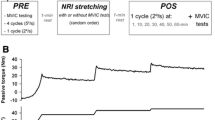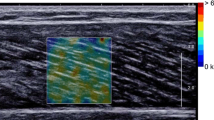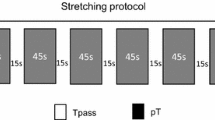Abstract
Purpose
We investigated the effects of plantarflexor static stretching of different intensities on the medial gastrocnemius (GAS) shear elastic modulus, GAS fascicle length and ankle passive torque–angle responses during and after stretching.
Methods
Participants performed three stretching sessions of different intensities: 40 % (R40) of maximal dorsiflexion range of motion (ROM), 60 % (R60) of ROM, and 80 % (R80) of ROM. Each stretching lasted 10 min. The GAS architecture, GAS shear elastic modulus, ankle passive torque–angle, and muscle activity were assessed before, during, and after the stretching.
Results
The absolute and relative (i.e., normalized to the static stretching start value) GAS shear elastic modulus relaxation varied across stretching intensities. The absolute passive torque relaxation varied across intensities (p < 0.05) but not when normalized to the stretching start value. No significant changes were observed in GAS fascicle length during the stretching (p = 0.93). After stretching, passive torque at a given angle was significantly decreased for R60 [−0.99 ± 0.59 Nm (−6.5 ± 3.8 %), p < 0.001] and R80 [−1.05 ± 1.12 Nm (−6.8 ± 6.3 %), p = 0.004], and GAS shear elastic modulus decreased only for the R80 [−9.3 ± 7.2 kPa (−14.1 %), p = 0.003]. No significant correlations were found between the magnitude of relaxation during stretching and post-stretching effect in the GAS shear elastic modulus or ankle passive torque variables. No significant relation was found between the shear elastic modulus and the ankle passive torque responses during and after stretching.
Conclusion
The effects of stretching on joint passive torque do not reflect changes in the medial gastrocnemius shear elastic modulus, and these responses to stretching depend on its intensity.




Similar content being viewed by others
Abbreviations
- CI:
-
Confident interval
- EMG:
-
Electromiography
- GAS:
-
Gastrocnemius medialis
- ICC:
-
Intraclass correlation coeficient
- MTJ:
-
Muscle-tendon junction
- r :
-
Pearson correlation coeficient
- R40:
-
40 % of maximal dorsiflexion range of motion
- R60:
-
60 % of maximal dorsiflexion range of motion
- R80:
-
80 % of maximal dorsiflexion range of motion
- ROM:
-
Range of motion
- SEM:
-
Standard error of measurement
- SSI:
-
Supersonic shear imaging
References
Abbott B, Lowy J (1956) Stress relaxation in muscle. Proc R Soc Lond 146B:281–288. doi:10.1098/rspb.1957.0011
Akagi R, Takahashi H (2013) Acute effect of static stretching on hardness of the gastrocnemius muscle. Med Sci Sports Exerc 45:1348–1354. doi:10.1249/MSS.0b013e3182850e17
Baumgart E (2000) Stiffness—an unknown world of mechanical science? Injury 31(Suppl 2):S-B14–S-B23. doi:10.1016/S0020-1383(00)80040-6
Bercoff J, Tanter M, Fink M (2004) Supersonic shear imaging: a new technique for soft tissue elasticity mapping. IEEE Trans Ultrason Ferroelectr Freq Control 51:396–409. doi:10.1109/TUFFC.2004.1295425
Bojsen-Møller J, Schwartz S, Kalliokoski K, Finni T, Magnusson S (2010) Intermuscular force transmission between human plantarflexor muscles in vivo. J Appl Physiol (1985) 109:1608–1618. doi:10.1152/japplphysiol.01381
Cabido C, Bergamini J, Andrade A, Lima F, Menzel H, Chagas M (2014) Acute effect of constant torque and angle stretching on range of motion, muscle passive properties, and stretch discomfort perception. J Strength Cond Res 28:1050–1057. doi:10.1519/JSC.0000000000000241
Cronin NJ, Carty CP, Barrett RS, Lichtwark G (2011) Automatic tracking of medial gastrocnemius fascicle length during human locomotion. J Appl Physiol (1985) 111:1491–1496. doi:10.1152/japplphysiol.00530.2011
Freitas SR, Vaz JR, Bruno PM, Valamatos MJ, Andrade RJ, Mil-Homens P (2014) Are rest intervals between stretching repetitions effective to acutely increase range of motion?. Int J Sports Physiol Perform (in press)
Freitas SR, Vilarinho D, Vaz JR, Bruno PM, Costa PB, Mil-Homens P (2014) Responses to static stretching are dependent on stretch intensity and duration. Clin Physiol Funct Imaging (in press)
Gajdosik RL (2001) Passive extensibility of skeletal muscle: review of the literature with clinical implications. Clin Biomech (Bristol, Avon) 16:87–101
Gajdosik RL (2006) Influence of a low-level contractile response from the soleus, gastrocnemius and tibialis anterior muscles on viscoelastic stress-relaxation of aged human calf muscle-tendon units. Eur J Appl Physiol 96:379–388. doi:10.1007/s00421-005-0091-7
Gennisson JL, Deffieux T, Macé E, Montaldo G, Fink M, Tanter M (2010) Viscoelastic and anisotropic mechanical properties of in vivo muscle tissue assessed by supersonic shear imaging. Ultrasound Med Biol 36:789–801. doi:10.1016/j.ultrasmedbio.2010.02.013
Herbert RD, Clarke J, Kwah LK, Diong J, Martin J, Clarke EC, Bilston LE, Gandevia SC (2011) In vivo passive mechanical behaviour of muscle fascicles and tendons in human gastrocnemius muscle-tendon units. J Physiol 589:5257–5267. doi:10.1113/jphysiol.2011.212175
Herda T, Costa P, Walter A, Ryan E, Hoge K, Kerksick C et al (2011) Effects of two modes of static stretching on muscle strength and stiffness. Med Sci Sports Exerc 43:1777–1784. doi:10.1249/MSS.0b013e318215cda9
Hopkins WG (2000) Measures of reliability in sports medicine and science. Sports Med 30:1–15
Hug F, Lacourpaille L, Maïsetti O, Nordez A (2013) Slack length of gastrocnemius medialis and Achilles tendon occurs at different ankle angles. J Biomech 46:2534–2538. doi:10.1016/j.jbiomech.2013.07.015
Kato E, Kanehisa H, Fukunaga T, Kawakami Y (2010) Changes in ankle joint stiffness due to stretching: the role of tendon elongation of the gastrocnemius muscle. Eur J Sport Sci 10:111–119. doi:10.1080/17461390903307834
Kay AD, Blazevich AJ (2009) Moderate-duration static stretch reduces active and passive plantar flexor moment but not Achilles tendon stiffness or active muscle length. J Appl Physiol (1985) 106:1249–1256. doi:10.1152/japplphysiol.91476.2008
Koo T, Guo J, Cohen J, Parker K (2013) Relationship between shear elastic modulus and passive muscle force: an ex vivo study. J Biomech 46:2053–2059. doi:10.1016/j.jbiomech.2013.05.016
Kubo K, Kanehisa H, Fukunaga T (2002) Effect of stretching training on the viscoelastic properties of human tendon structures in vivo. J Appl Physiol (1985) 92:595–601. doi:10.1152/japplphysiol.00658.2001
Light K, Nuzik S, Personius W, Barstrom A (1984) Low-load prolonged stretch vs. high-load brief stretch in treating knee contractures. Phys Ther 64:330–333
Magnusson SP, Simonsen EB, Aagaard P, Gleim GW, McHugh MP, Kjaer M (1995) Viscoelastic response to repeated static stretching in the human hamstring muscle. Scand J Med Sci Sports 5:342–347. doi:10.1111/j.1600-0838.1995.tb00056.x
Magnusson S, Simonsen E, Aagaard P, Kjaer M (1996) Biomechanical responses to repeated stretches in human hamstring muscle in vivo. Am J Sports Med 24:622–628. doi:10.1177/036354659602400510
Maïsetti O, Hug F, Bouillard K, Nordez A (2012) Characterization of passive elastic properties of the human medial gastrocnemius muscle belly using supersonic shear imaging. J Biomech 45(6):978–984. doi:10.1016/j.jbiomech.2012.01.009
McHugh M, Cosgrave C (2010) To stretch or not to stretch: the role of stretching in injury prevention and performance. Scand J Med Sci Sports 20:169–181. doi:10.1111/j.1600-0838.2009.01058.x
McHugh M, Magnusson S, Gleim G, Nicholas J (1992) Viscoelastic stress relaxation in human skeletal muscle. Med Sci Sports Exerc 24:1375–1382
Mizuno T, Matsumoto M, Umemura Y (2013) Decrements in stiffness are restored within 10 min. Int J Sports Med 34:484–490. doi:10.1055/s-0032-1327655
Morse CI, Degens H, Seynnes OR, Maganaris CN, Jones DA (2008) The acute effect of stretching on the passive stiffness of the human gastrocnemius muscle tendon unit. J Physiol 586:97–106. doi:10.1113/jphysiol.2007.140434
Nakamura M, Ikezoe T, Takeno Y, Ichihashi N (2013) Time course of changes in passive properties of the gastrocnemius muscle-tendon unit during 5 min of static stretching. Man Ther 18:211–215. doi:10.1016/j.math.2012.09.010
Nakamura M, Ikezoe T, Kobayashi T, Umegaki H, Takeno Y, Nishishita S, Ichihashi N (2014) Acute effects of static stretching on muscle hardness of the medial gastrocnemius muscle belly in humans: an ultrasonic shear-wave elastography study. Ultrasound Med Biol. doi:10.1016/j.ultrasmedbio.2014.03.024
Noorkoiv M, Stavnsbo A, Aagaard P, Blazevich AJ (2010) In vivo assessment of muscle fascicle length by extended field-of-view ultrasonography. J Appl Physiol (1985) 109:1974–1979. doi:10.1152/japplphysiol.00657.2010
Nordez A, McNair PJ, Casari P, Cornu C (2009) The effect of angular velocity and cycle on the dissipative properties of the knee during passive cyclic stretching: a matter of viscosity or solid friction. Clin Biomech (Bristol, Avon) 24:77–81. doi:10.1016/j.clinbiomech.2008.10.004
Tian M, Hoang PD, Gandevia SC, Bilston LE, Herbert RD (2010) Stress relaxation of human ankles is only minimally affected by knee and ankle angle. J Biomech 43:990–993. doi:10.1016/j.jbiomech.2009.11.017
Tian M, Herbert R, Hoang P, Gandevia S, Bilston L (2012) Myofascial force transmission between the human soleus and gastrocnemius muscles during passive knee motion. J Appl Physiol (1985) 113:517–523. doi:10.1152/japplphysiol.00111.2012
Usuba M, Akai M, Shirasaki Y, Miyakawa S (2007) Experimental joint contracture correction with low torque—long duration repeated stretching. Clin Orthop Relat Res 456:70–78. doi:10.1097/BLO.0b013e31803212bf
Acknowledgments
The authors are grateful to all participants involved in the study. The study was funded by grants from the European Regional Development Fund (ERDF, n°37400), the French Muscular Dystrophy Association (AFM, contract no. 14084) and the Region des Pays de la Loire.
Conflict of interest
The authors declare no conflict of interest.
Author information
Authors and Affiliations
Corresponding author
Additional information
Communicated by Olivier Seynnes.
Rights and permissions
About this article
Cite this article
Freitas, S.R., Andrade, R.J., Larcoupaille, L. et al. Muscle and joint responses during and after static stretching performed at different intensities. Eur J Appl Physiol 115, 1263–1272 (2015). https://doi.org/10.1007/s00421-015-3104-1
Received:
Accepted:
Published:
Issue Date:
DOI: https://doi.org/10.1007/s00421-015-3104-1




